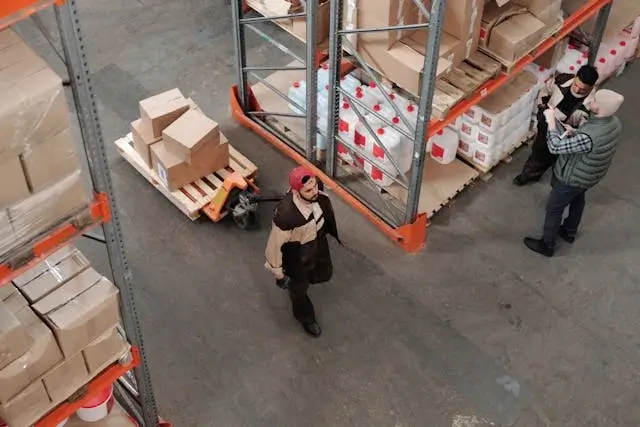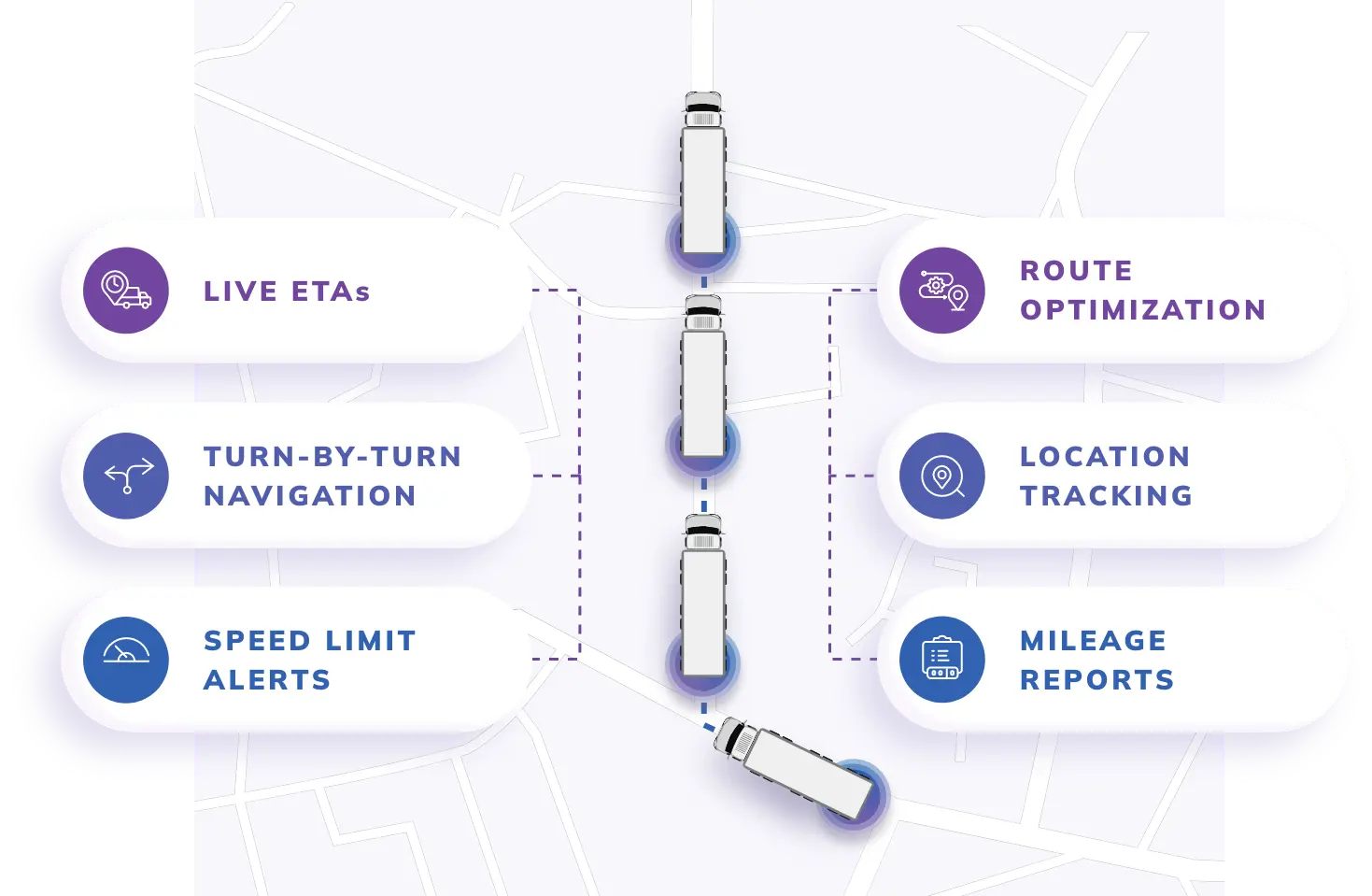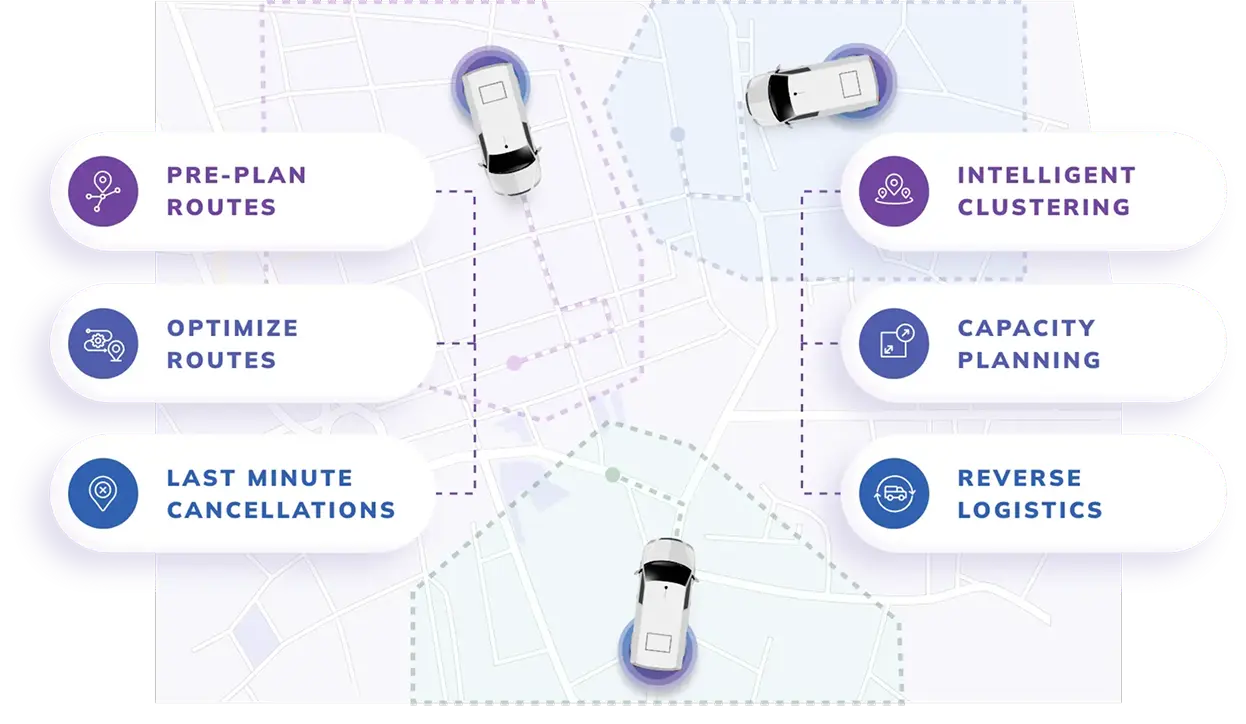

- BLOG
Latest Route Optimization Trends and Statistics for 2025 (Detailed Guide)
Published: June 24, 2025
Route Optimization API
Optimize routing, task allocation and dispatch
Distance Matrix API
Calculate accurate ETAs, distances and directions
Directions API
Compute routes between two locations
Driver Assignment API
Assign the best driver for every order
Routing & Dispatch App
Plan optimized routes with 50+ Constraints
Product Demos
See NextBillion.ai APIs & SDKs In action
AI Route Optimization
Learns from Your Fleet’s Past Performance
Platform Overview
Learn about how Nextbillion.ai's platform is designed
Road Editor App
Private Routing Preferences For Custom Routing
On-Premise Deployments
Take Full Control of Your Maps and Routing
Trucking
Get regulation-compliant truck routes
Fleet Management
Solve fleet tracking, routing and navigation
Middle Mile Delivery
Optimized supply chain routes
Construction
Routes for Construction Material Delivery
Oil & Gas
Safe & Compliant Routing
Food & Beverage
Plan deliveries of refrigerated goods with regular shipments
Table of Contents

Route optimization sounds like a clean, logical concept on paper. Take a bunch of stops, figure out the shortest or fastest way through them, and send the vehicle out. But anyone who has touched real-world logistics knows it is never that simple. By the time the driver leaves the depot, the entire plan might already be half broken. Traffic changes, customers reschedule, and one vehicle shows up half-loaded. Weather hits. Someone forgets to scan a package. Nothing stays fixed for long.
That is why modern route optimization has nothing to do with just plotting points on a map. It is about building resilient plans that actually survive the day. In 2025, optimization platforms are less about theory and more about stability under stress. They factor in live traffic, stop windows, vehicle load capacities, weather risks, fuel prices, road restrictions, and all the unpredictable things that happen between Point A and Point Z. The best ones do not just recommend what looks good. They build what can be trusted.
The stakes are high. If your operation depends on deliveries, pickups, service calls, or mobile teams of any kind, then routing is not just a technical layer. It is the nervous system of the business. If the routes are wrong, everything downstream suffers. You get late arrivals, missed appointments, high fuel bills, frustrated drivers, and unhappy customers. You get chaos. And if you are trying to scale while living in that chaos, it only gets worse.
Here are the pieces that actually make route optimization work or fail:
Route optimization is not a feature inside your navigation app. It is the backbone of how vehicles move through multi-stop operations. The goal is simple to say but hard to do. You need to figure out which vehicle should go where, in what order, at what time, while respecting all the hard rules of your operation. That includes delivery windows, driver schedules, vehicle limits, service durations, traffic flows, and a dozen other moving parts that do not always play nice together.
It is not about the shortest distance. It is about finding the best possible sequence that fits reality, which often means compromising. You cannot send a small van to deliver a commercial fridge. You cannot show up at a customer site before they open. You cannot take a heavy truck through a residential lane with weight restrictions. The optimizer needs to know all of this. And it needs to turn that into something that makes the day feel less painful for drivers and dispatchers, not more.
If you do not have proper routing in place, then everyone is guessing. Dispatchers spend their mornings manually dragging stops around a map, hoping it looks efficient. Drivers follow routes that make no sense. Deliveries run late and fuel burns faster than it should. Customers keep asking when their order will arrive, and support teams do not have an answer. It becomes reactive firefighting all day, every day.
When route optimization is done properly, the difference is immediate. Routes get faster, cleaner, and far more predictable. Drivers do not waste time backtracking or calling in for clarifications. Dispatchers stop fixing broken plans and start improving workflows. Customers receive tighter ETAs and fewer delays. Fuel costs go down, overtime drops, and suddenly, the entire operation feels lighter.
The other big win is visibility. With smarter routing in place, you do not just see where vehicles are, you see where the entire schedule is going. You know which stops are risky, which ones are likely to run late, and where you can make up time. Good systems learn as they go. They adjust for local patterns, driver speed, service time anomalies, and historical slowdowns. They make the next route smarter because of what happened today.
Here are the moving parts behind a system that actually does what it promises:
The engine starts with raw input. And this is where a lot of teams mess up. The optimizer needs clean, reliable data about addresses, stop priorities, service durations, driver availability, vehicle capacity, road constraints, customer preferences, and time windows. If any of that is fuzzy or outdated, the entire route will start off flawed. So the process begins by structuring all of that chaos into something a system can work with.
Once the input is stable, the constraints come in. These are the rules you cannot break. A certain truck cannot carry more than two tons. A technician cannot arrive after 4 PM. A customer requires a temperature-controlled vehicle. A delivery has to happen between 11 and 1, not earlier, not later. These rules are not suggestions. They define the limits of what the route can and cannot do.
Now comes the hard part. The optimizer runs simulations. It generates route combinations, scores them based on time, cost, distance, reliability, and any custom business logic you care about. It compares thousands of options in seconds. The output is not just a pretty line on a map. It is a plan that actually fits the real-world constraints and gives your team the highest odds of getting through the day without unnecessary chaos.
And that plan keeps evolving. If traffic hits, the route adapts. If a customer cancels, the sequence updates. If a driver falls behind, the system adjusts downstream stops. The best platforms do not treat routing as a one-time event in the morning. They treat it as a living process that breathes with the day.
You could have the smartest algorithm on the planet, but if you feed it garbage data, the routes will collapse. This is where most operations struggle. Addresses are incorrect. Delivery notes are missing. Drivers do not clock in properly. Maps are out of date. The inputs are flawed, so the output is too. And no optimizer can fix bad fundamentals.
What works is constant data hygiene and feedback loops. You need real-time traffic feeds, GPS updates, clean address validation, driver performance tracking, and historical stop data. That way the system is not building routes in a vacuum. It is learning from actual delivery behavior.
Weather is a factor, too. Systems that pull in weather conditions and historical delay zones will build more resilient routes. They will avoid zones that slow down in the rain. They will flag risky segments before they become problems.
And one more thing: the system has to be aware of your geography. A platform that was built for North America may fail completely in South Asia if it cannot parse informal addresses, interpret local road logic, or factor in regional delivery behaviors. That is where customization matters. Because optimization only works when it matches the way your world actually operates.
Following are the industries and operational scenarios where route optimization makes or breaks performance:

This is the heartland of route optimization. In logistics, every wasted kilometer, every wrong turn, every idle minute at a blocked junction, all of it burns money. And when you are managing fleets that run across cities, states, or borders, these small inefficiencies scale into massive losses fast.
Most logistics companies do not fail because of lack of demand. They fail because their systems cannot keep up with the volume or unpredictability. Orders pile up. Vehicles get overused. Routes get thrown together manually. Then one traffic jam or vehicle breakdown sets off a chain of delays that affects dozens of customers. The operation never fully recovers by the end of the day.
What route optimization does in logistics is bring some order to that mess. The right platform reduces miles driven without cutting stops. It reorders drop sequences to make better use of time. It balances workloads so that no single vehicle is overloaded while others are running half empty. It plans with real constraints, not idealistic maps that ignore road conditions, loading times, or driver hours.
And when things go wrong, which they always do, the better systems reroute on the fly. If a delivery point becomes unreachable or a truck gets delayed, the software adjusts everything around it. Loads are reassigned. Stops are resequenced. Routes evolve in real time, not on someone’s clipboard.

If logistics is where route optimization proves its worth, then last-mile is where it shows its limits. This is the part of the chain where complexity becomes deeply personal. A package is not just one of a thousand anymore. It is someone’s grocery order. Someone’s medicine. Someone’s replacement laptop for work. If it is late or lost or left at the wrong door, that is your brand on the line.
And the last-mile is hard. You are delivering into apartment buildings with security gates. You are handling addresses that barely exist on a map. You are squeezing multiple stops into narrow delivery windows in zones where parking does not exist. Drivers get lost, run behind, or show up only to find out the customer has stepped out. Multiply that by hundreds of routes and thousands of packages, and you have a serious problem.
Route optimization solves this by reducing the randomness. It clusters deliveries logically instead of just by zip code. It accounts for real access issues. It optimizes not only the route order, but also how long a driver is likely to spend at each stop. And it keeps adapting as new orders come in or traffic shifts during the day.
In urban zones, it focuses on speed and density. In rural zones, it focuses on coverage and fuel conservation. The best systems handle both without needing a separate setup. That flexibility is what separates tools built for scale from tools built for demos.
Routing is not only about packages. It is about people. Field technicians, inspectors, installation teams, all of them move across a city or region, trying to stay on time while dealing with unknowns at every stop. Missed appointments cost time, money, and client trust. Overbooked schedules lead to burnout. Underutilized technicians waste payroll.
The real challenge in field service is not the driving. It is the planning. Technicians need to be routed not just based on location, but on skillset, job complexity, customer availability, and service duration. You cannot send a junior tech to fix an elevator in a commercial complex. You cannot send someone across town at 4 PM and expect them to finish two more jobs that day.
Route optimization helps by sequencing service orders in a way that respects all of those variables. It assigns the right person to the right job at the right time. And it makes sure the route they follow is not just logical, but physically doable. Some platforms also allow dispatchers to update the day’s plan mid-shift if a job runs long or short. That means better use of team hours and fewer service-level violations.
When implemented correctly, route optimization in field services does not just reduce travel time. It improves technician performance, reduces customer churn, and builds an operation that feels in control, even when the schedule changes ten times before lunch.
Following are the actual systems and innovations powering smarter routing in 2025:
There are many tools that promise route optimization. Fewer deliver it at the scale and speed modern operations require. And even fewer still can handle the mess that comes with large, high-velocity logistics.
Nextbillion.ai
This platform was not built for perfect conditions. It was built for messy ones. It handles real-world data like incomplete addresses, region-specific delivery behaviors, and flexible business rules. Whether you are doing ride-hailing, last-mile logistics, or fleet dispatch, it lets you tune the optimizer to your world, not just hope the defaults fit. It supports offline routing, custom constraints, and real-time re-optimization without needing the whole system to pause.
Route4Me
A solid choice for small to mid-size teams that need better routing without a massive onboarding process. It works well for basic logistics, recurring deliveries, or mobile teams that just need to reduce driving time and fuel. The system is intuitive and quick to deploy, though it may not handle the edge cases that larger teams deal with daily.
OptimoRoute
This one focuses on combining scheduling and routing. It is often used by field service teams, where the job type matters as much as the location. The tool can factor in technician skill, customer preferences, and time-on-site when building routes. That extra context can make a big difference when every stop is not the same.
Google Maps and Waze APIs
These are not full optimization engines, but a lot of early-stage teams still rely on them for navigation, traffic data, and ETAs. They are useful, but the moment you need multi-stop planning, vehicle-level constraints, or live rerouting, you will need something stronger sitting on top of them. Think of these as ingredients, not the final product.
What separates today’s platforms from the tools of five years ago is not just faster algorithms. It is smarter ones. AI in routing is not a gimmick anymore. It is a core layer of how the best systems work.
Machine learning can analyze thousands of past routes, identify where things consistently go wrong, and start correcting for it before it happens again. If a route always runs ten minutes late between two stops, the system learns. If a certain technician always finishes faster in a specific zone, the system adjusts future schedules to take advantage of that.
AI also helps with preplanning. Instead of waiting for all orders to be in before generating a route, the system starts preparing clusters in advance, based on historical demand, weather, or even time of day. That makes the entire routing process feel less last-minute and more predictive.
It is not about replacing the human planner. It is about giving them a system that already knows what success looks like, based on thousands of previous failures.
Following are the persistent headaches that routing platforms must solve if they are going to work in the real world.
The single most frustrating thing about routing is how quickly a solid plan can fall apart. A route looks perfect at 7:00 AM. By 9:15 AM, one road closure and two traffic incidents later, everything is broken. The driver is behind. The stops are out of sync. The rest of the day becomes guesswork.
Old systems freeze once a route is dispatched. They cannot adapt. That is where most of the damage happens. Drivers start improvising. Dispatchers get stuck reassigning stops manually. Customers are waiting without updates. One delay multiplies into ten.
Modern route optimization platforms are finally treating this like a live system. They pull traffic data in real time. They integrate driver GPS updates directly. When congestion hits, the system does not just send a warning. It reroutes everything, instantly. It reshuffles stop orders. It adjusts estimated arrival times. It gives the driver a new path without needing to restart the entire plan.
And the better systems go a step further. They learn from the pain. If a specific highway always clogs up at 5:00 PM, the platform will avoid it next time. If a region has known traffic risks, it will build buffers into the schedule. You are no longer reacting. You are anticipating.
Planning a single delivery is easy. Planning a hundred of them with conflicting windows, vehicle types, service durations, traffic zones, and driver preferences is where most systems start to crack.
The biggest challenge is sequencing. You cannot just plug all your stops into a map and expect magic. Some deliveries must happen early. Some take longer. Some are located in restricted zones. Some require certain drivers. The moment you treat all stops the same, the optimization becomes useless.
High-quality routing engines use layered constraint logic. They apply business rules, traffic predictions, vehicle capabilities, and stop-specific logic all at once. They sequence stops not just for speed, but for practicality. They flag unserviceable stops before dispatch. They allow mid-day reshuffling without tearing the whole plan apart. And they do it fast. Because nobody has two hours to build a route while the fleet sits idle.
Here are examples where real operations got real results using the right optimization platform.
A national delivery provider operating in major cities across Southeast Asia was stuck. They were dealing with too many failed deliveries, driver turnover was spiking, and route plans were being patched manually every morning. Their city maps looked clean, but on the ground, informal addresses, building access issues, and unpredictable traffic patterns turned every day into chaos.
They moved to a routing system that allowed address parsing by region, live rerouting mid-shift, and contextual logic that matched how people actually described locations. That shift did not just improve plans. It changed the culture. Drivers stopped wasting time calling dispatch for help. Delivery windows became accurate. Customer complaints dropped. Missed stops went down by 30 percent within one quarter.
The company did not add more vehicles. It just gave the ones it already had better instructions.
A regional distribution business that handled perishable goods across semi-urban zones in India was burning through fuel and hours without understanding where the waste was happening. Their trucks came back half-full, their loading schedules were off, and return trips were completely unplanned. Every planner had their own method and none of them matched.
They switched to a machine learning-powered optimizer that focused on balancing outbound and inbound routes. It started identifying common inefficiencies like backtracking, overloading one route while underutilizing another, and wasting warehouse proximity. Within two months, fuel usage dropped by nearly 20 percent. Fleet productivity went up. Routes became more consistent and less dependent on one planner’s instincts.
Over time, the system even recommended warehouse layout changes. It spotted physical inefficiencies no one on the ground had connected until the data pointed it out.
Here are the trends and shifts that will define routing over the next few years:
Optimization is no longer a backend engine that just calculates paths. It is becoming a front-line decision-maker. Companies are expecting more from their routing platforms. It is not enough to get packages delivered. Routes must now balance cost, timing, customer experience, environmental impact, and last-minute flexibility.
Sustainability is entering the conversation. Businesses are starting to measure routes by carbon output, not just fuel efficiency. They are asking platforms to reduce delivery emissions, minimize empty miles, and even account for urban noise regulations and delivery curfews.
AI is getting deeper into the logic. Platforms are no longer waiting for something to go wrong before they react. They are predicting it ahead of time. If a stop tends to run long, the system adjusts the next route before dispatch. If a zone shows higher delivery failures on weekends, the route plan avoids it until Monday. This is not just optimization. It is operational foresight.
Privacy is also rising fast. Customers want their location and delivery data protected. That means more on-device routing, less cloud dependency, and stricter handling of delivery history. The platforms that ignore this will lose trust fast.
The global route optimization market is growing fast. Forecasts put it past ten billion dollars by 2027, but the more important metric is who is buying and why. It is not just logistics firms anymore. It is e-commerce startups, government fleets, maintenance services, health supply chains, and rideshare operators. Routing is becoming horizontal.
Companies that used to rely on Google Maps and a spreadsheet are now moving to full-scale optimizers because the risks of being late, inefficient, or unscalable are too high. Investors are backing platforms that can run globally and locally at the same time. Teams are shifting from static plans to dynamic operations.
Routing is no longer a small lever. It is now one of the most critical components of how you serve, scale, and stay competitive.
Routing is not a nice-to-have anymore. It is not a software plugin or a background tool for your dispatch team. It is the system that tells your vehicles where to go, how to move, when to arrive, and what to prioritize when everything else goes wrong. And it is the system that separates the operations that hold together from the ones that fall apart.
In 2025, if you are not treating route optimization as a core piece of infrastructure, you are already behind. The companies that win are the ones who route better, not just faster. They build plans that flex, absorb impact, and get stronger over time. Their drivers trust the system. Their customers trust the schedule. Their planners stop guessing and start managing. Routing is not about the shortest path. It is about control.
There is no single answer because it depends on the use case. However, Nextbillion.ai is one of the top platforms for real-world flexibility. It handles region-specific formats, live reoptimization, dynamic constraints, and custom logic in a way that matches the complexity of actual field operations.
AI is used to detect patterns, predict disruptions, learn from route performance, adjust ETAs based on driver behavior, cluster stops based on demand, and forecast problems before they happen. It is not just speeding up routing. It is making it smarter with every shift.
Logistics, e-commerce, field services, ride-hailing, healthcare delivery, infrastructure inspection, government fleet ops, waste collection, and utilities, if your business moves people or goods between multiple locations, then you need route optimization that works in your world.
Bhavisha Bhatia is a Computer Science graduate with a passion for writing technical blogs that make complex technical concepts engaging and easy to understand. She is intrigued by the technological developments shaping the course of the world and the beautiful nature around us.